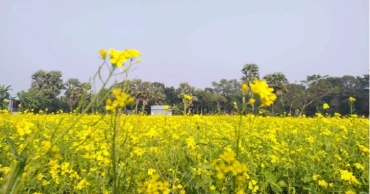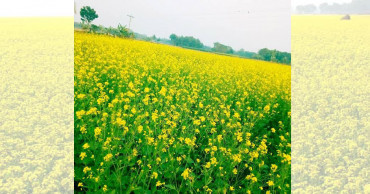Mustard
Haor farmers reap early gains as mustard cultivation flourishes in Sunamganj
A vast golden carpet has spread across the haor wetlands of Madhyanagar upazila in Sunamganj, as a bumper mustard harvest this season brings renewed hope and financial relief to local farmers.
The low-lying fields, riverbanks and wetlands of Banshikunda Uttar and Dakshin, Chamardani and Madhyanagar Sadar unions are now awash with bright yellow mustard flowers, transforming the landscape into a striking spectacle that is also drawing curious visitors.
Mustard, widely known as a low-cost and high-profit oilseed crop with a short growing cycle, has gained growing popularity among farmers in the haor region.
According to the Madhyanagar upazila agriculture office, mustard was cultivated on around 550 hectares of land this season, with officials optimistic about meeting, and possibly exceeding production targets.
Read more: Chuadanga farmers thrive as cauliflower yields hit new high
For many farmers, the shift towards mustard has been driven by rising production costs and price uncertainty surrounding paddy and other staple crops. “We often suffer losses from rice cultivation due to high input costs and unstable market prices,” said one farmer. “Mustard needs less investment, grows quickly and sells well. It is safer for us.”
As a result, mustard cultivation has expanded significantly in fallow lands and haor-adjacent areas this year, making productive use of land that often remains uncultivated after the monsoon.
The agriculture office said sowing typically begins at the end of Kartik, with harvesting completed by mid-Poush, allowing farmers to earn returns early in the season.
Even before harvesting the seeds, farmers generate additional income by selling mustard flowers and leaves, which are used locally to prepare dishes such as bora (fritters) and leafy vegetables.
After harvesting, the dried stalks are sold as fuel, further adding to household earnings.
Read more: Sirajganj’s mustard fields bloom into golden seas, promise bumper harvest
Upazila Deputy Assistant Agriculture Officer Akmal Hossain said the outlook remains positive. “Like previous years, the mustard production target has been achieved. If there is no major pest or disease outbreak, farmers can expect a bumper harvest,” he said.
He said timely distribution of fertilisers and seeds under government incentive programmes ensured smooth cultivation this season.
Across Bangladesh, mustard cultivation has emerged as a profitable rabi-season crop, particularly in districts such as Magura and Narail.
With the Bangladesh Agricultural Research Institute (BARI) keeps on developing high-yielding mustard varieties to support the farmers and keep up the encouraging growth trend, farmers have responded equally with the adoption of improved seeds and modern techniques.
Mustard farming is playing an increasingly vital role in Bangladesh’s agricultural economy with the country striving to reduce its dependence on imported edible oil, officials said.
Read more: Naogaon farmers make a fortune on mustard and honey
4 days ago
Sirajganj’s mustard fields bloom into golden seas, promise bumper harvest
Vast stretches of mustard fields across Sirajganj have burst into radiant shades of yellow, turning the district into a rolling sea of gold and offering a visual feast that is delighting visitors and farmers alike.
From late afternoon until dusk, the flowering fields have become a magnet for people of all ages. Youths, women and men are seen wandering through the blossoms, pausing to admire the view, capturing selfies against the glowing backdrop of nature’s seasonal spectacle.
The golden transformation is most striking in Tarash, Raiganj, Ullapara and the char areas—long known as the district’s ‘granary’—where mustard flowers sway gently in the winter breeze, painting the countryside with warmth and colour.
Read more: Golden Harvest: Sirajganj farmers reap bumper mustard crop
According to the Department of Agricultural Extension (DAE), a cultivation target of 87,125 hectares was set for mustard farming across Sirajganj’s nine upazilas this season.
Farmers, however, have gone beyond expectations, bringing even more land under cultivation and raising hopes of a bumper harvest.
Mustard farming has expanded notably in the Chalan Beel areas, particularly in Tarash, Raiganj, Ullapara and Shahjadpur upazilas. Significant cultivation has also been recorded in Kamarkhanda, Kazipur, Belkuchi and Sirajganj Sadar upazilas, reflecting a district-wide surge in production.
Among the commonly cultivated varieties are Tori-7, BARI-14, Beena-9 and Beena-14. In the char areas, farmers have opted for the uric acid-free Kalania variety, well-suited to the region’s soil and conditions.
Read more: Chapainawabganj farmer sparks local excitement with amazing Chinese orange harvest
Local farmers said government incentives have played a crucial role in encouraging cultivation. Seeds and fertilisers were distributed at fixed rates, while agricultural officers provided regular guidance and technical advice to ensure better yields.
With favourable weather prevailing, farmers remain optimistic about achieving a bumper output this season.
Adding to the vibrancy of the fields, honey collectors from different areas have already installed bee boxes among the mustard crops. Harvesting of mustard flower honey has begun, and collectors expect production to surpass last year’s levels due to the increased acreage under cultivation.
Deputy Director of the DAE, AKM Manjur-e-Maula, said farmers had brought more land under mustard cultivation this year compared to the previous season.
“We distributed free seeds and fertilisers among small and marginal farmers and provided necessary advice. If the weather remains favourable, there is a strong possibility of a bumper mustard harvest this season,” he said.
As Sirajganj’s fields glow under winter skies, the mustard bloom stands not only as a scenic delight but also as a symbol of agricultural promise and rural resilience.
Read more: Khulna farmers reap rewards from mustard cultivation, honey production
11 days ago
Govt initiative to reduce edible oil imports: Jashore’s mustard farmers anticipate exceptional harvest
The mustard farmers of Jashore district are anticipating a record production and significant profits this year, thanks to favorable weather conditions and enhanced government support.
The Jashore Department of Agriculture Extension (DAE) revealed that the area under mustard cultivation surpassed the initial target of 29,900 hectares, reaching 30,265 hectares. This increase is a part of the government’s initiative to reduce edible oil imports, as highlighted by DAE sources.
Election 2024: Crude bomb blast at Jashore polling centre injures 1
A visit to Churamonkathi village in Sadar upazila showcased vast fields adorned with vibrant mustard flowers. The farmers have adopted Bari-9 and Bari-14 mustard varieties, with the government providing each farmer with one kg of seeds and 20 kg of fertilizers per bigha of land to encourage cultivation.
Jabed Ali, a farmer from Kulia village in Jhikargacha upazila, shared his optimism: “Compared to other crops like paddy, mustard cultivation is less expensive and more profitable. That’s why many of us have chosen to cultivate mustard.”
7 crude bombs explode in 2 polling centres in Jashore
The farmers are optimistic about the harvest, which is expected to begin within the next 20-25 days. “If the weather remains favorable, we anticipate a bumper yield,” Ali added.
Zahidur Rahman, another farmer from Keshabpur upazila, echoed this sentiment: “Last year, I harvested five maunds of mustard. With the current conditions, I expect an even greater yield this year.”
Dr. Sushanta Kumar Tarafdar, Deputy Director of DAE, underscored the government’s commitment to reducing edible oil imports. “By increasing the cultivation of Robi season crops like mustard, we aim to achieve this goal. This year, Jashore has seen a record yield,” he stated.
National Polls: 275 polling stations out of 825 are vulnerable in Jashore
The government provided seeds and fertilizers to 37,800 farmers across the district, including those in Abhaynagar upazila, where mustard cultivation covered 2,110 hectares.
The concerted efforts of the farmers, favorable weather, and government support have combined to set the stage for a highly successful mustard harvest in Jashore, marking a significant stride in Bangladesh’s agricultural sector.
1 year ago
Farmers expect bumper mustard yield in Khulna
Farmers and agriculture officials in Khulna district are expecting a bumper production of mustard as improved varieties of mustard were cultivated on a record amount of land this season.
Mustard cultivation is gaining more popularity among the farmers in the district as they got good yield as well as good price of the winter crop last year.
This season 289 hectares of land have been brought under mustard cultivation in nine upazilas and in the city.
Khulna Cancer hospital project sees slow progress
The flourishing mustard crops have transformed the landscape, with farmers envisioning higher yields as they witness the blooming flowers.
In addition to getting seeds and fertilizers as incentives, last year’s good yield motivated farmers to bring more land under mustard cultivation, said the officials of the Department of Agricultural Extension(DAE) who also hope that every mustard farmer will get more profit this year if the weather remains favourable.
According to DAE of Khulna district, mustard has been cultivated on 1,954 hectares of land in the district this season. Of these, mustard has been cultivated on 14 hectares in Daulatpur metropolitan area, 7 hectares in Labanchara, 305 hectares in Rupsha upazila, 250 hectares in Batiaghata upazila, 120 hectares in Dighalia upazila, 180 hectares in Phultala upazila, 420 hectares in Dumuria upazila, 160 hectares in Terokhada upazila, 28 hectares in Dacope upazila, 260 hectares in Paikgachha upazila and 210 hectares in Koyra upazila. Last year, mustard was cultivated on 1,665 hectares of land in the distict.
Jan 7 election: Jatiya Party candidates at loggerheads over withdrawal from the race in Khulna
Meanwhile, the DAE has provided 13,600 farmers with seeds and fertilizers for cultivation of 1,820 hectares of land in the district.
Each of the 50 farmers of Daulatpur metropolitan area, 50 farmers of Labanchara, 2,000 farmers of Rupsha upazila, 1,800 farmers of Batiaghata, 1,200 farmers of Dighalia, 1,400 farmers of Phultala, 2,300 farmers of Dumuria, 1,200 farmers of Terokhada, 300 farmers of Dacope, 1,800 farmers of Paikgachha and 1,500 farmers of Koyra was given one kg of seeds, 10 kg DAP fertilizer and 10 kg MOP fertilizer as incentives.
Mustard farmers Ansar Ali, Abdus Samad and Soluar Shahid of Gopalpur village in Paikgachha upazila said the mustard cultivated in their fields has been good and they were motivated by the Agriculture Office.
Paikgachha Upazila Agriculture Officer Ashim Kumar Das said, mustard cultivation was delayed due to delay in harvesting paddy. If farmers cultivate early varieties of paddy, they will be able to cultivate mustard on time after harvesting paddy, he added.
‘Dog meat biryani’ at Tk 30 per packet: Khulna police arrest 4 people
Farmers are being encouraged to cultivate early varieties of paddy and mustard cultivation in the upazila has been good this year, he said.
Kazi Jahangir Hossain, deputy director of the Department of Agricultural Extension, Khulna, said, farmers have been given incentives like last year to increase oil seed production. “Our field workers are constantly assisting the farmers with necessary advice. Hopefully, there will be a good yield and it will be helpful in meeting the demand of edible oil.”
2 years ago
Mustard farmers in Madaripur eye huge profit this year
Madaripur mustard farmers are passing very busy time in harvesting the crop as they have achieved bumper yield this year and are expecting huge profit.
The farmers have been showing interest in mustard farming this year thanks to the higher price of edible oil in the market. Farmers have brought over 2000 hectares of land under mustard cultivation this year against the previous year.
According to the District Agriculture Extension department information, mustard is cultivated on 15,650 hectares of land in four upazilas of the district this year against 13,604 hectares of land in the previous year.
Merjon Khalasi, a mustard farmer of the district, said that mustard is being sold at the rate of Tk 3,300 to Tk 3,500 per maund (37.32 kg).
Generally, 12 to 13 maund mustard can be produced from one bigha of land costing Tk 8,000 to Tk 9,000, Merjon Khalasi added.
Md. Moazzem Hossain, Deputy Director of district Agriculture Department, said that four upazilas of Madaripur got bumper production this year. We hope farmers will earn good profit this year.
The government has a plan to produce 50 percent of the annual demand for edible oil in the country in the next three years, said Minister for Agriculture Dr Md Abdur Razzaque at a programme in Gazipur ecently.
The minister said the mustard farmers are getting benefited financially by cultivating such hybrid varieties of mustard redesigned by the country’s agriculturalists.
The Agricultural Ministry has taken a massive initiative to boost up the mustard production, he said.
2 years ago
Kurigram mustard growers expect bumper yield
Mustard growers in Kurigram district are expecting a bumper yield as they cultivated more land exceeding the target due to low production cost and favourable weather.
Department of Agriculture Extension (DAE), Kurigram officials said prices of soybean and palm oil have risen sharply in the last two years and increased mustard cultivation can be a solution to edible oil crisis.
Read more: Floating vegetable farmers in Pirojpur devastated by low prices
During a recent visit to the mustard fields in the district, the UNB correspondent found that a vast tracts of barren land have been brought under mustard cultivation .
DAE sources said, this year, a total of 16,400 hectares of land have been brought under mustard cultivation while it was 12,900 hectares last year.
Within two months of cultivation, mustard got matured for harvesting and the farmers have to spend Tk 4000-5000 per bigha of land. Usually 5000-6000 mounds of mustard are produced from one bigha of land.
Farmers said after harvest of Aman paddy the land remain uncultivated for 3/5 months and they cultivate mustard to utilise the land during the period. They will cultivate Boro paddy after yield of mustard.
Read more: BPC opens control room to monitor smooth supply of diesel farmers for irrigation
Deldar Hossain, a farmer of Uttar Nauabas in Pachgachi of Sadar upazila, said “Whatever I cultivate in this char land is often damaged by flood. So, I cultivated mustard after facing losses from Aman cultivation. I am happy now expecting a bumper mustard yield.”
Babul, another farmer of the area said “The lands of the area have remain under water for 3-4 months in a year and when farmers cultivate Aman they count a huge loss. The weather of the area is good for Boro and mustard cultivation. I have brought three bighas of land under mustard cultivation as I can earn some profit from it if weather remains favourable.”
Biplab Kumar Mohonta, deputy director of Kurigram DAE, said, “We are working to increase mustard production as mustard oil production is poor against the demand of the country. We have set a target to produce 50 percent edible oil in our country within several years.”
3 years ago
In Photos: Yellow mustard fields wear eye-catching look
Integrated farming of mustard and beekeeping in the same field is expanding in different parts of the country as it has been found to be very profitable.
4 years ago
Mustard, a ‘yellow gold’ for Benapole farmers
The high-yielding mustard seeds from Bangladesh Agriculture Research Institute (BARI) have given farmers in Sharsha upazila of the district something to be cheerful about years after low yield.
6 years ago















